| Let me start
by asking this question. "Could you light a bulb
with a battery and a wire?" Think about that for
awhile. Now here I have just this collection of parts. If
I handed these to you and said, "O.K. do it",
would you be able to light the bulb? How would this interaction go if you presented the question to some of the students here at Mines? How about if you confronted some of our recent graduates? |
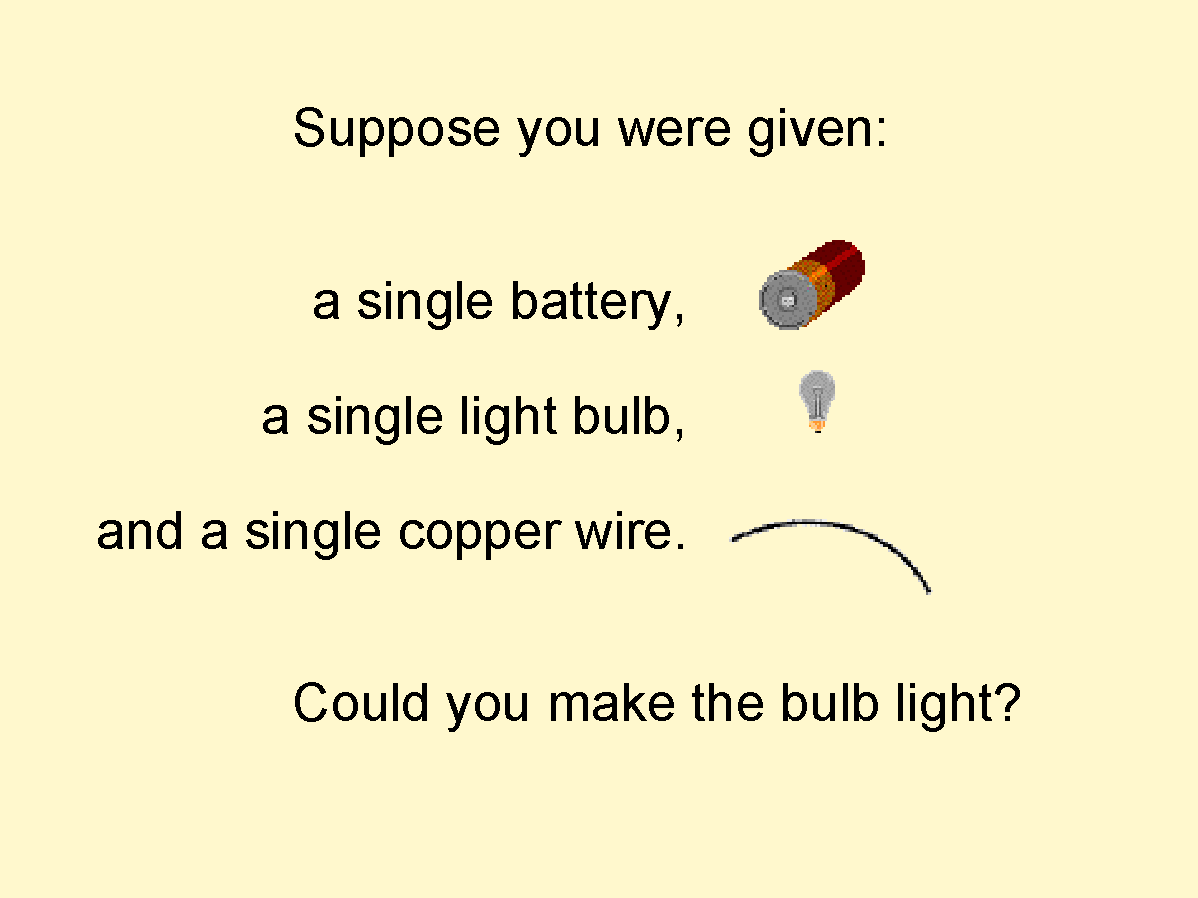 |
| Let’s
have a look at what happened when this same question was
asked of some recent graduates at MIT. (You can view the video "Can We Believe Our Eyes", as part of the program Minds of Our Own at: You might argue that this simple qualitative question has nothing to do with the sophisticated knowledge and skill possessed by an MIT or a Mines graduate. But that’s not the case. This little test exposes a serious flaw in conventional college teaching methods. Not only do these students have a poor understanding of the fundamental properties of electricity, but they also lack the critical thinking skills that would enable them to synthesize the answer to a perplexing problem. Are these not some of the most important learning objectives that should be part of an engineering degree? If students are this confused with a basic issue, what is the depth and quality of their grasp of more advanced topics? Let’s look at some additional evidence about this problem. ******** photo and videotape credit: |
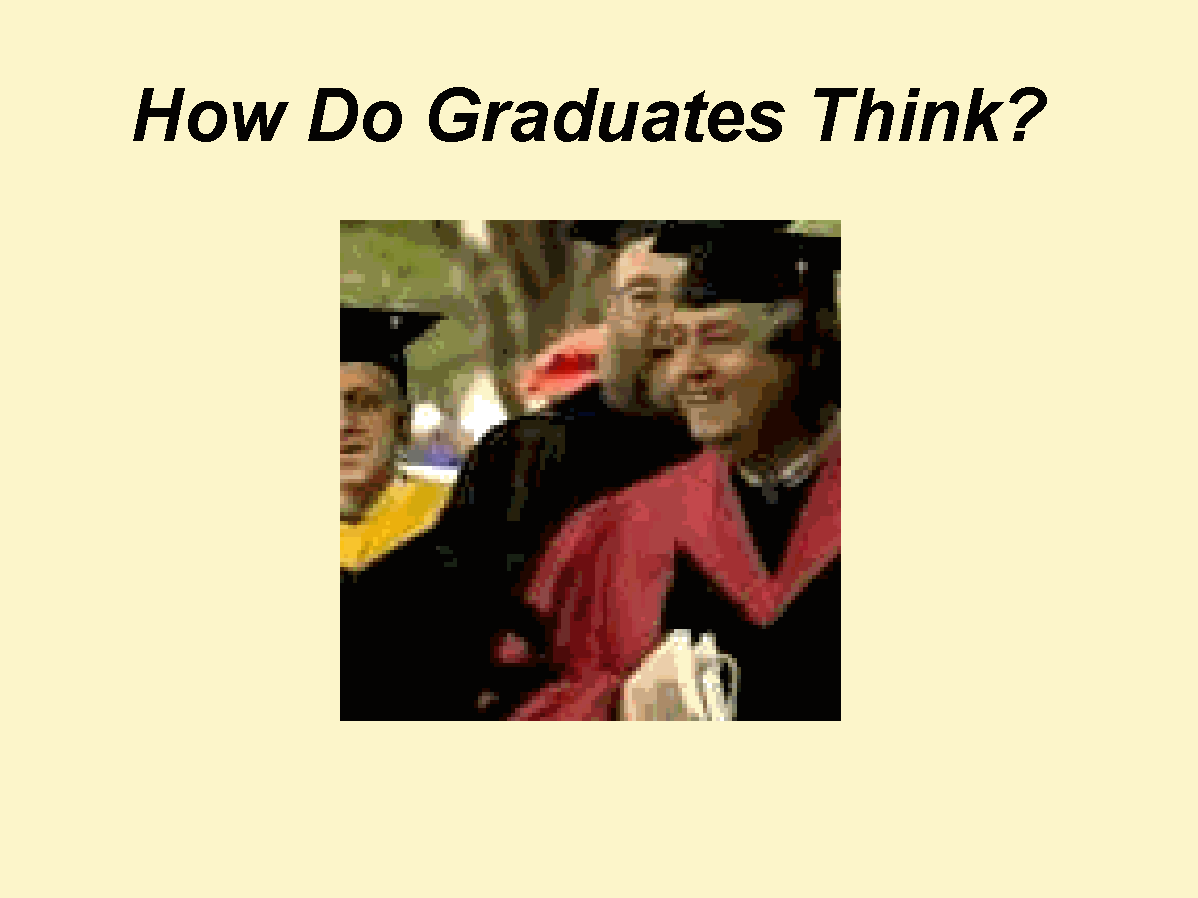 |
| This is a
question from the "Force-Concept Inventory", a
widely used instrument for evaluating conceptual
understanding of introductory mechanics. The test
contains 30 questions of similar difficulty. Take a
moment and read the question. Centripetal dynamics is one of the more non-intuitive issues that must be learned as part of any engineer’s education. I assure you that it is not possible to design a working automatic baggage transport system without a clear understanding of this principle. The correct choice is B. But that is not what most of the students choose, even at the end of a semester of study. |
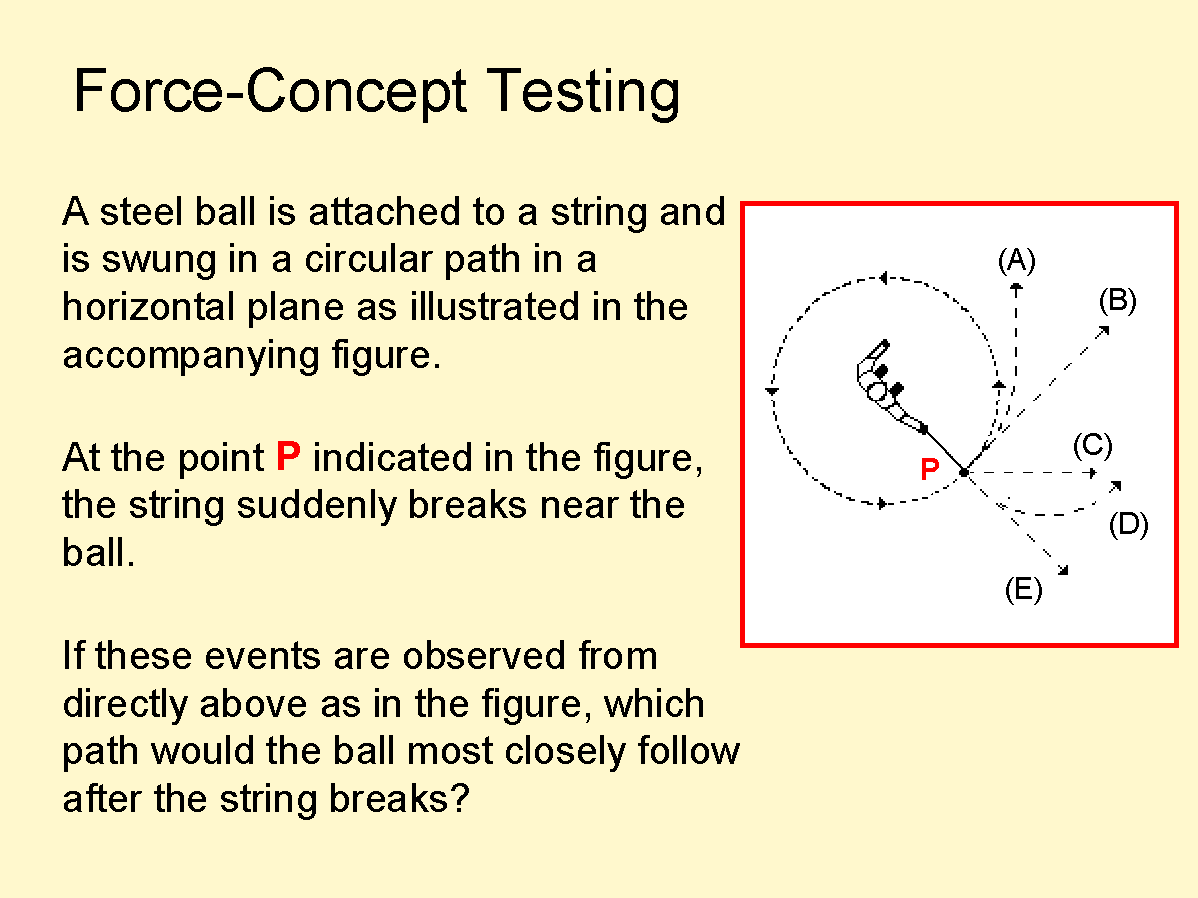 |
| The FCI has
been used all over the world for over ten years. The
statistics of what it is telling us are solid. This is a frequency histogram from part of one study. It concentrates on courses delivered by traditional teaching methods. In each of the 14 classes in the sample, the FCI was administered as a pre-test and again as a post-test. The horizontal axis is the fraction of the possible gain in raw score as a result of the learning experience. The range is from zero to about 80%. What this shows is that, on average, these traditional courses managed to improve the students’ scores by only 25% of the improvement that was possible. We have used the FCI here at Mines. In years past, when traditional teaching methods were in place, we have registered fractional improvements that have been as low as 10% . |
 |
| It is testing
like this that has raised a red flag not just at Mines,
but in all of higher education. And it’s not just in
physics that the problem has been observed. The AAAS and
the NSF have picked up this concern and have commissioned
several independent studies of the situation. The results
of these have been published in some notable reports. The
conclusions are very similar. "Graduates go out into
the workforce ill-prepared to solve real problems in a
cooperative way, lacking the skills and motivation to
continue learning." How is it possible for schools of engineering to turn out graduates who lack fundamental understanding and basic reasoning skills? What does this say about their abilities to lead their disciplines, or even to perform their entry-level jobs? It’s an important issue about which all of us should be concerned. Can we raise this institution to a higher level of teaching excellence? This question is the essence of my theme today. What I will present is not an attack but a self-examination. All of us who teach are interested in doing the best job that is practical within the constraints of other obligations. Recently I’ve come to understand the difference between covering material and facilitating learning. This comes not through original insight, but by paying attention to some very wise educators, including people on this campus, who have already figured this out. I have taught the wrong way for a long time, and I’m trying to make some changes. The biggest favor that I can do for you, and for the Colorado School of Mines, is to help you to start thinking in these directions also. Let’s start by having a look at the root of the problem. |
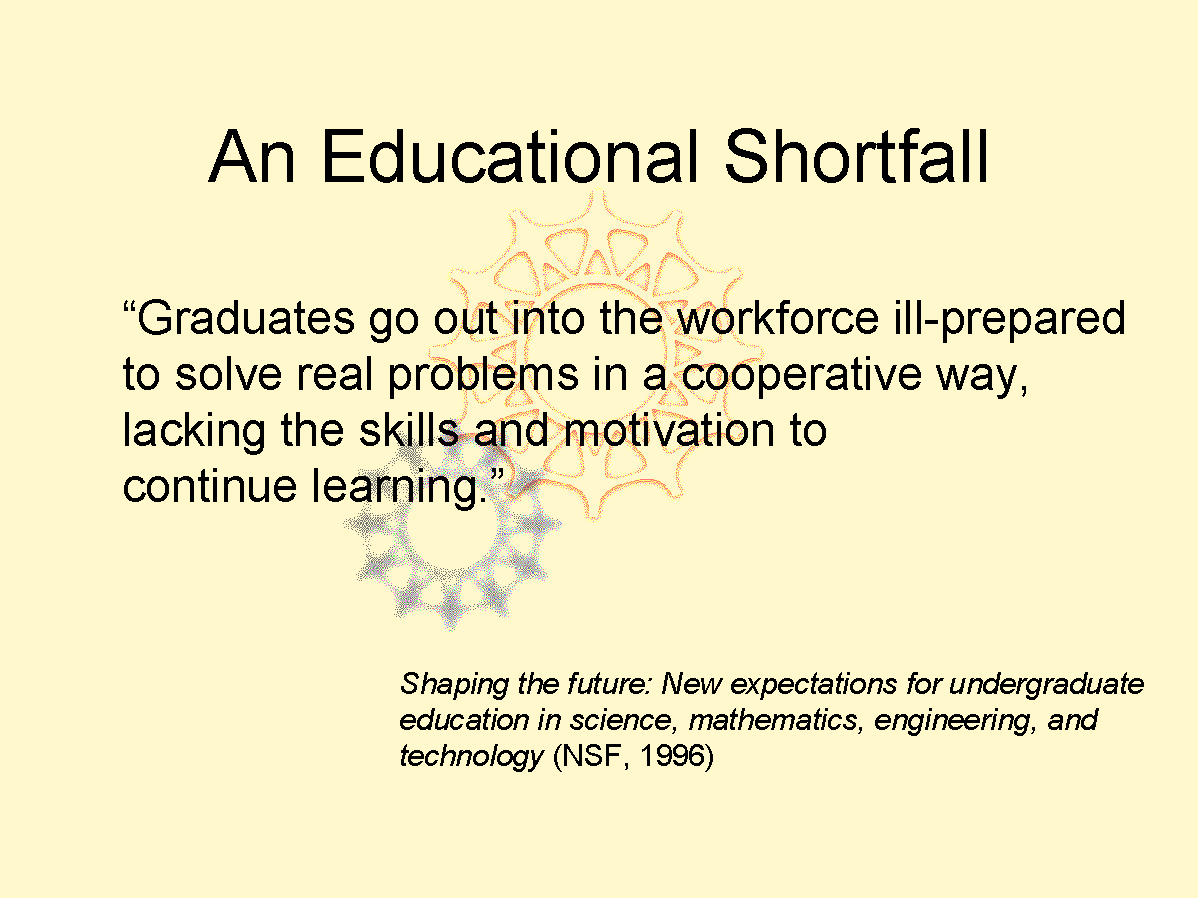 |
| This is the
auditorium in one of the most esteemed societies of
scholarship in the world: the Royal Institution of Great
Britain. Many great scholars have taught here: Thomas
Young, Michael Faraday, Lord Rayleigh. The room is
configured so that one person is the center of attention.
That person talks, and everyone else listens. This is the
academic lecture. It is our tradition. It’s the way
I was taught, and is probably the way you learned also. This teaching approach is part of what I’ll call the Old Paradigm of college teaching. Let’s see where it’s gotten us. ******** photo credit: |
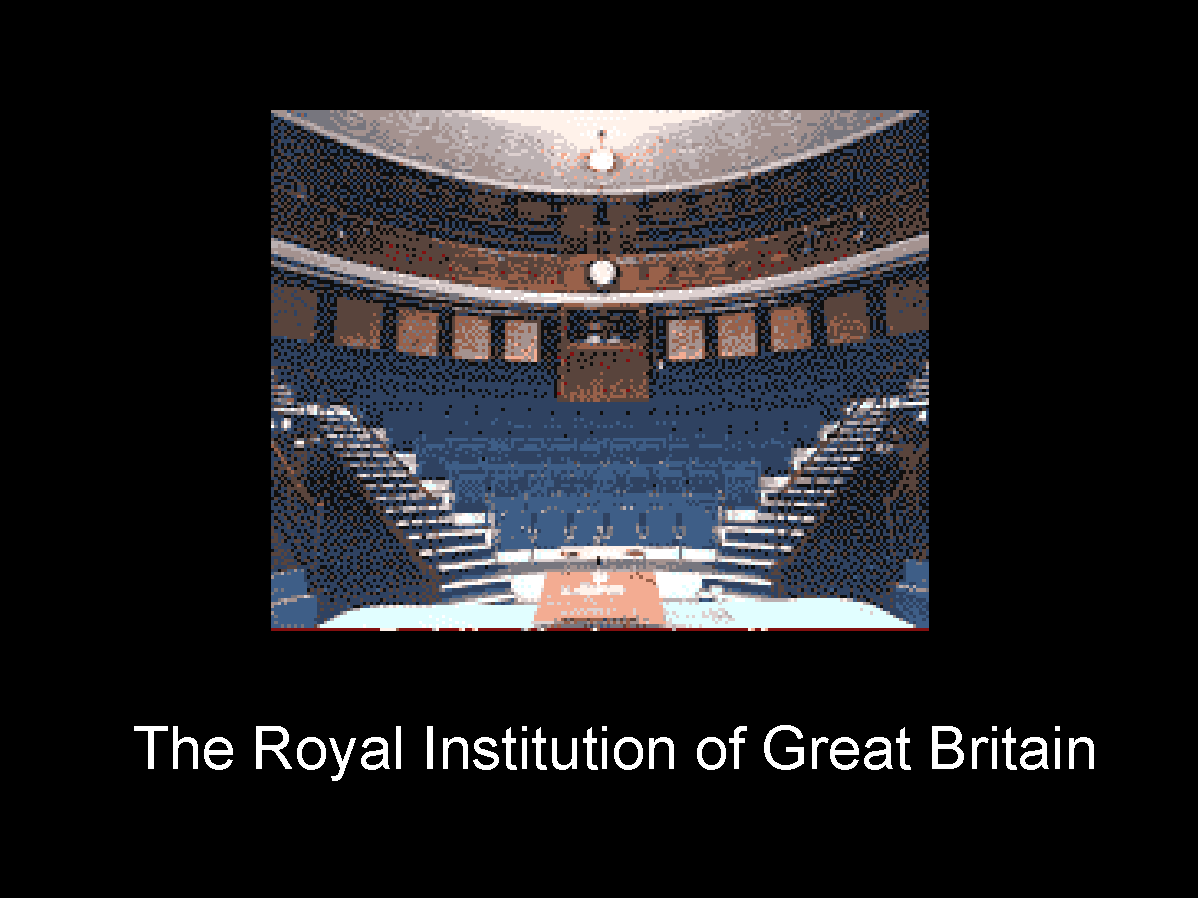 |
| Whether we
like it or not, this is the mode that most of our
students are in...and, if our only method of teaching is
by the traditional lecture, it’s our fault that they
are in this mode. The students sit in rows in class with the objective of writing down things that are written on the blackboard by the teacher. Problem assignments are finished as expediently as possible, with little critical thinking. Information and examples can be temporarily stored for the purpose of passing a test. But there has been no intellectual growth. Why is that? |
 |
| There are
several inherent problems with the lecture method of
teaching. It has been proven by controlled studies that most students (and other adults) simply can’t pay attention very long to someone who is just talking. That’s why they get into the "write it now and figure it out later" mode. Once that happens the lecture session becomes a tremendous waste of valuable teaching time. |
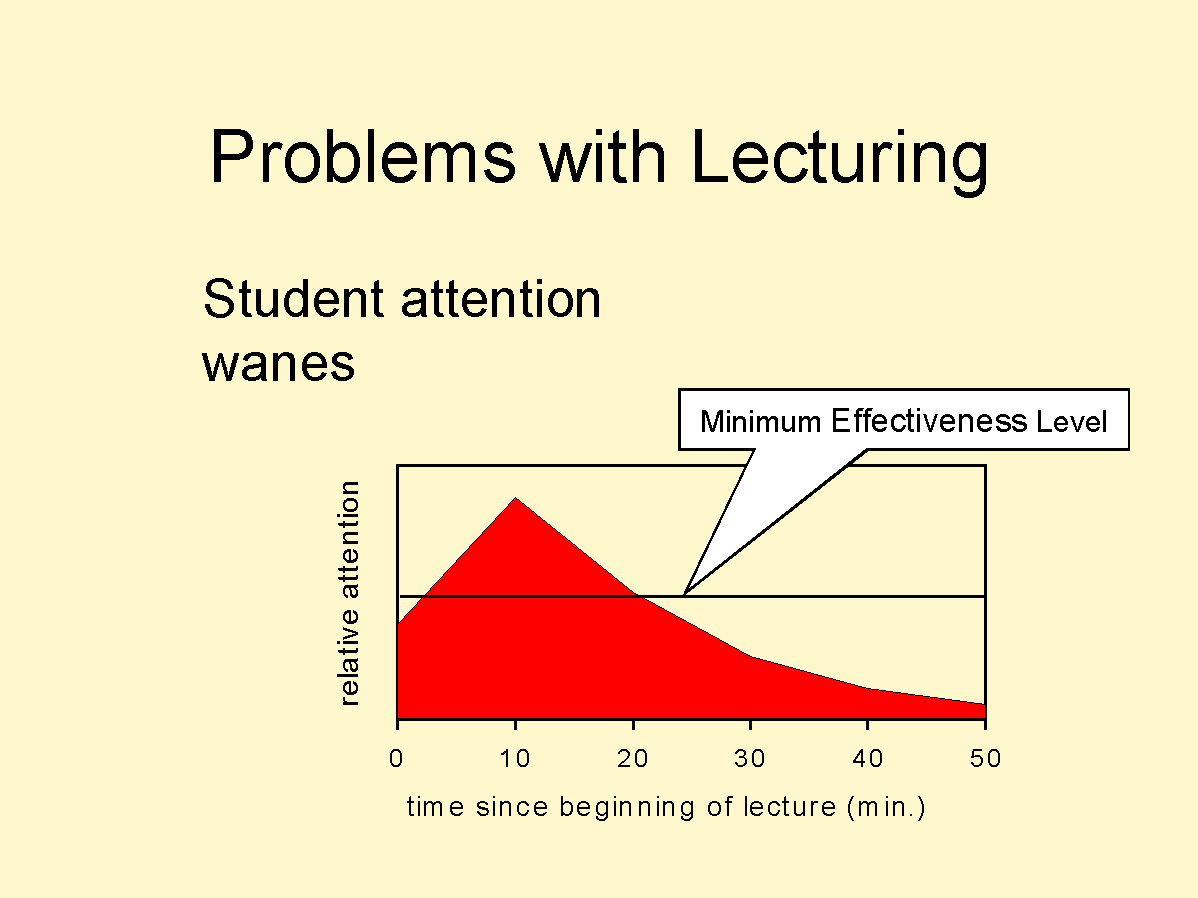 |
| Not all
lectures are boring, of course. The late Richard Feynman
was a master lecturer. The New York Times called him the
"impossible combination of theoretical physicist and
circus barker, all body motion and sound effects". However, even if we could always maintain a student’s attention, it’s true that only lower-level thinking is taking place in their minds. Good scientists and engineers are that way because they are able to think critically about complex material. This ability is not developed through lecturing. |
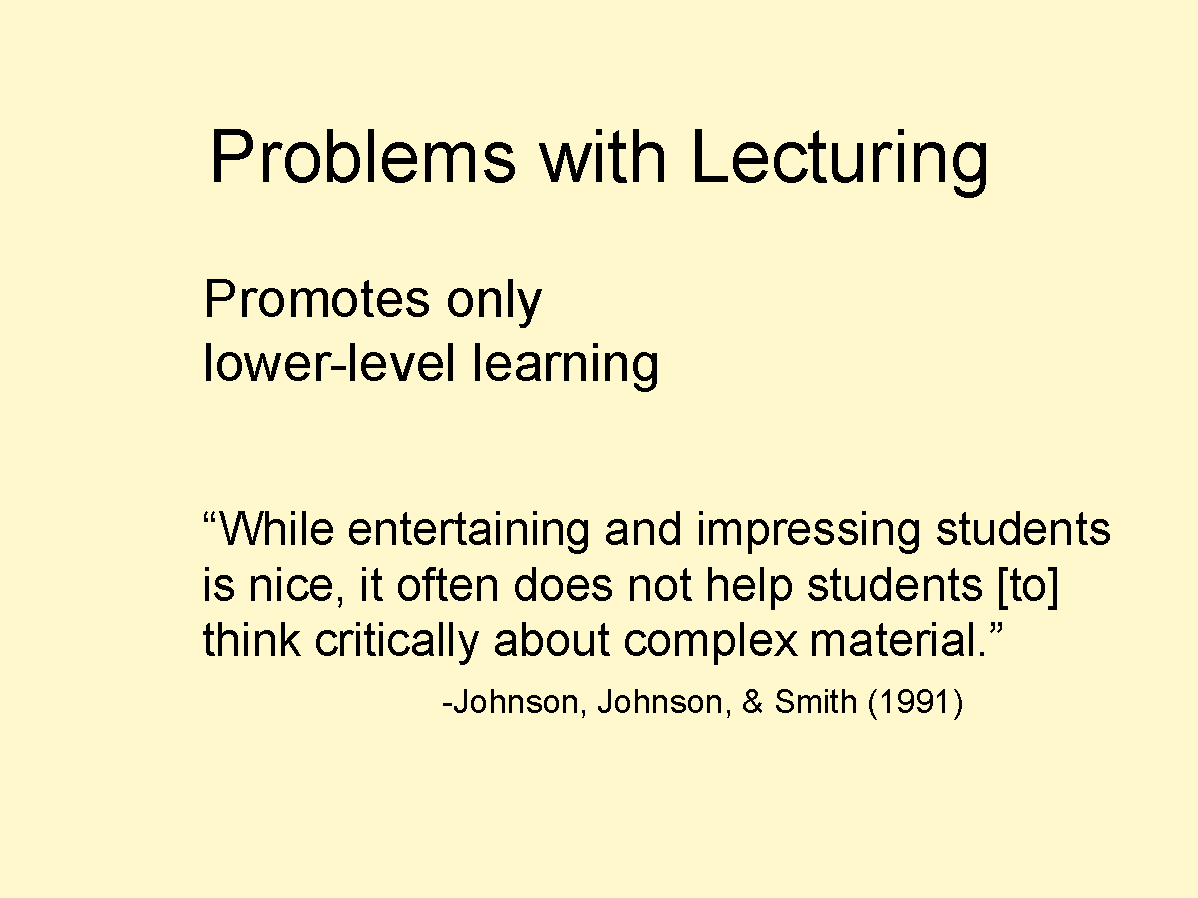 |
| The
fundamental problem with the lecture method of teaching
is that it is based on incorrect ideas about learning. The assumption goes like this: If I know something, then the way to teach it to you is to tell you about it. Your mind is an empty container in which I deposit my knowledge. If you can’t understand it this way, then I’ll re-explain it in a different way. This is supposed to go on until you get it. But that’s not the way learning works. ******** photo credit: Johnson, Johnson, & Smith (1991) |
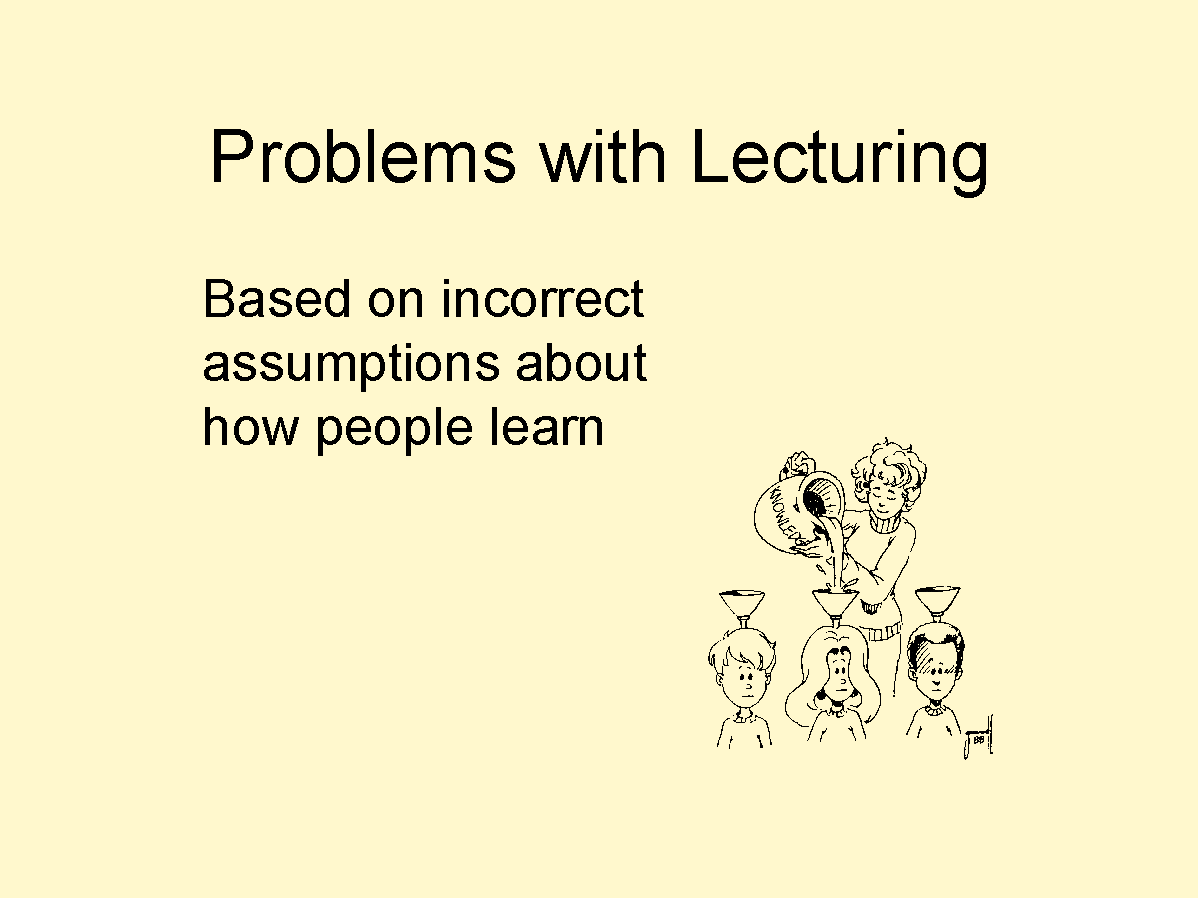 |
| The modern
understanding of mental processing of information was
formulated many decades ago by learning psychologists
such as Jean Piaget and John Dewey. However, the person
who figured it out most clearly was Lev Vygotsky, a
brilliant scholar who performed his research in Russia
under the Soviet regime. (His work was not published in
the west until about 40 years ago.) Some important elements of Vygotsky’s view are that: -knowledge is constructed by the learner -prior conceptions are the starting place for new knowledge -people must interact with each other to learn effectively Let’s see how this works... ******** photo credit: http://curriculum.calstatela.edu/faculty/psparks/theorists/501vygot.htm |
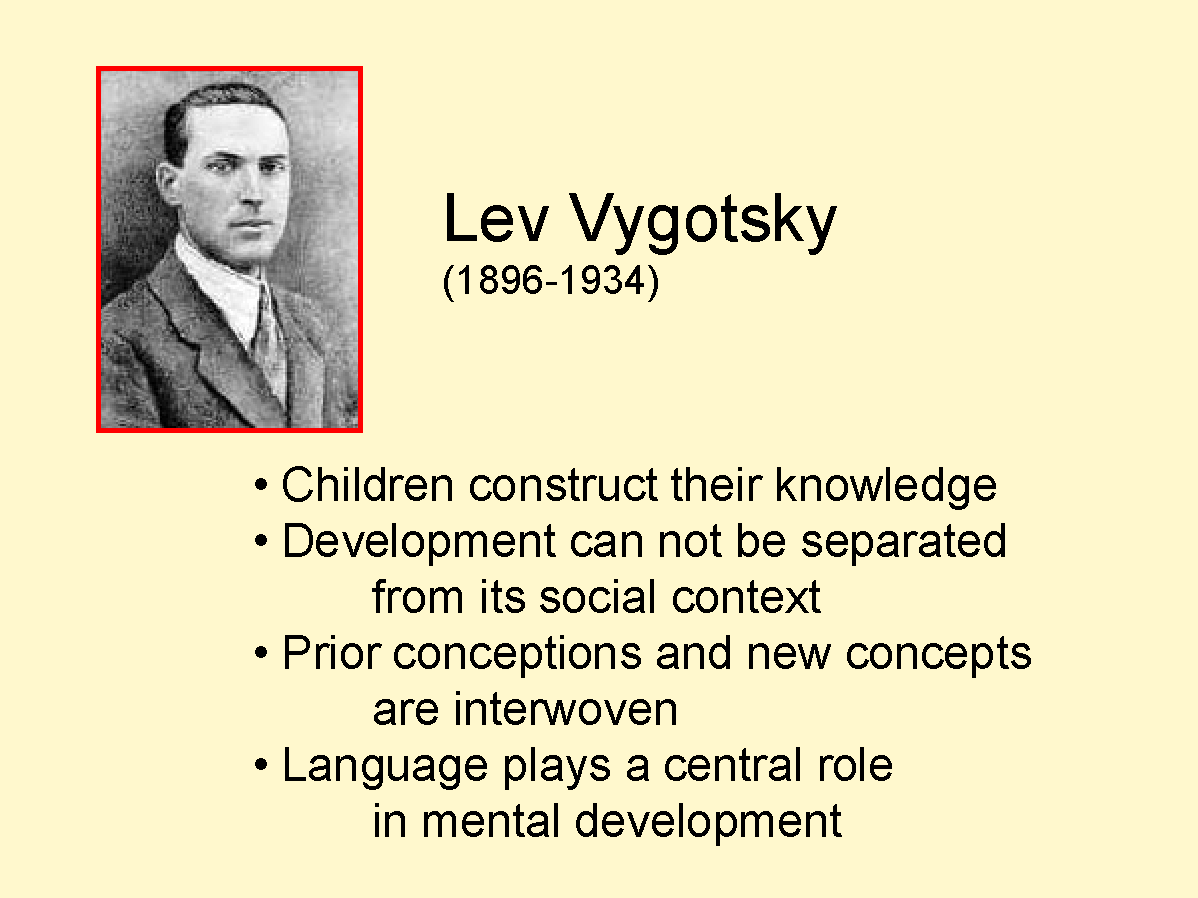 |
| What is this?
Some people ‘see’ a aerial photograph, others
detect the coat of a spotted cow, still others visualize
the image of a face. What each person ‘sees’
depends on what already happens to be stored in that
person’s brain. Learning from our senses is,
therefore, an active process. New knowledge is a mix of
incoming information and prior impressions. ******** figure credit: John Lawrence Bencze, University of Toronto, http://www.oise.utoronto.ca/~lbencze/Constructivism.html |
 |
| The National
Research Council recently published an excellent summary
of learning research. Here are some of the things that
are pointed out. * they like their notions * these notions often contradict those of the teacher Students must be
actively engaged in forming new knowledge Learning is context sensitive Students must be allowed to
reflect In-depth coverage of fewer
topics is the key to understanding |
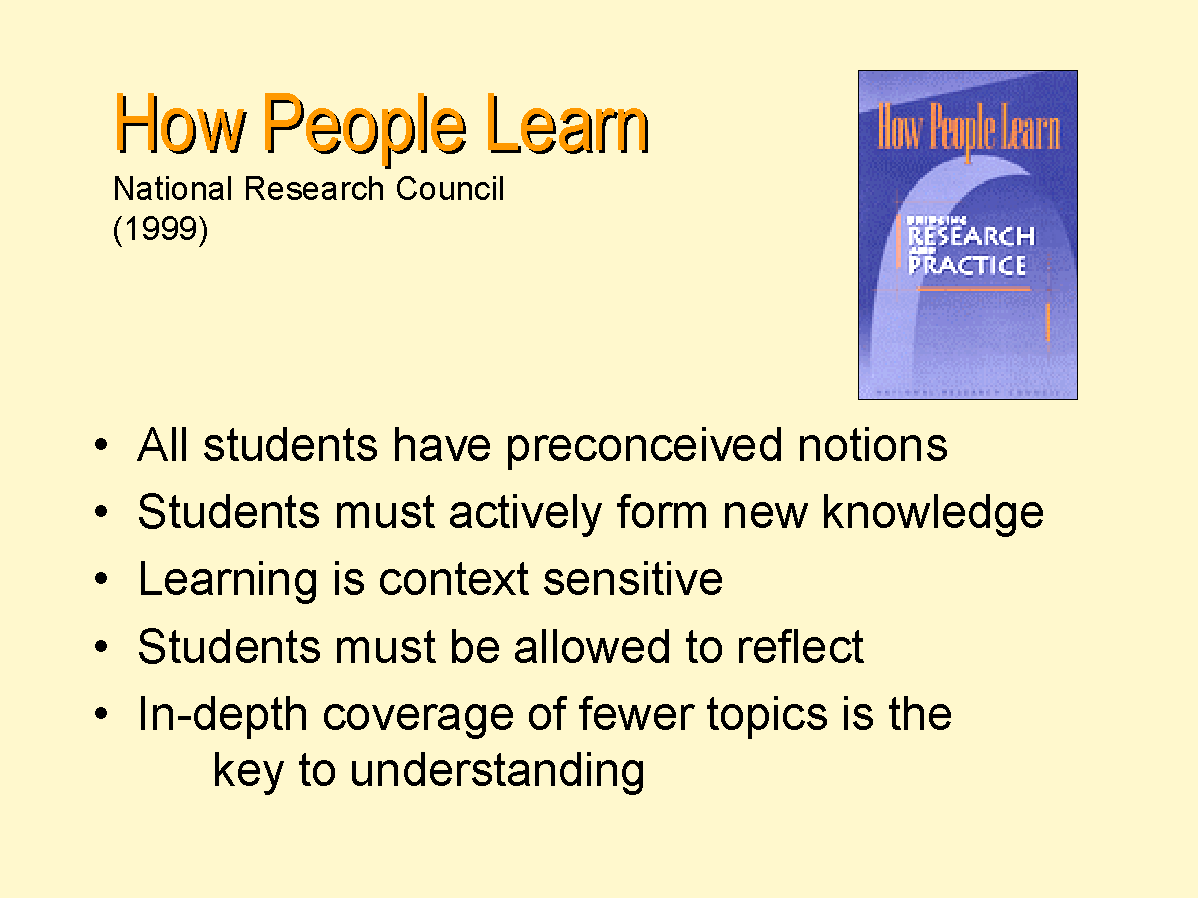 |
| With this
background about how people learn, you can see that there
needs to be a different approach to teaching. It’s
called Constructivism. This is a well-established principle in new teacher training at the K-12 level, and the foundation of, for example, the Colorado Model Content Standards, that all schools are now held responsible for achieving. It is not normally a requirement for a teacher at the university level to have received any exposure to effective teaching strategies prior to their employment. So it’s no wonder that we don’t know very much about constructivism. |
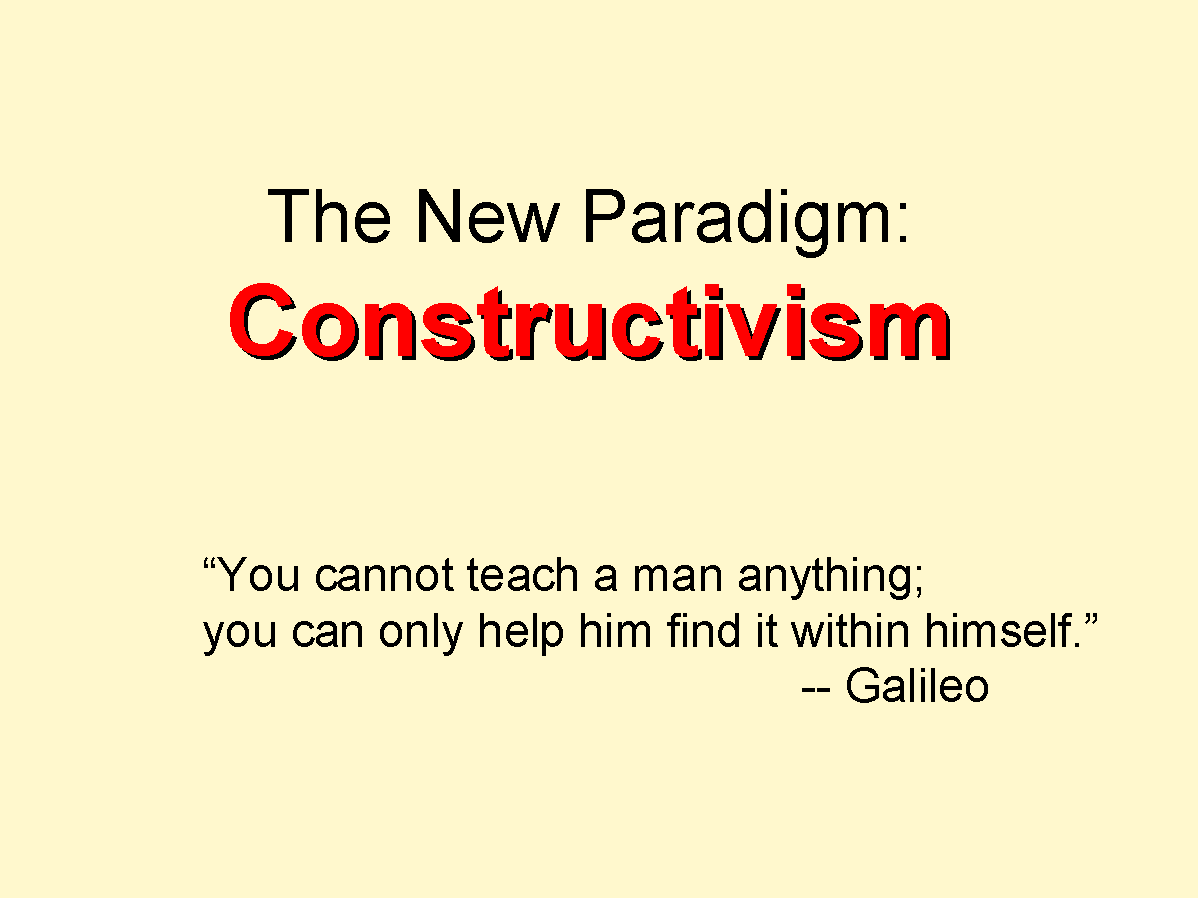 |
| Before I go on, however, I need to point out that there are plenty of examples at Mines where constructivist learning is effectively in place. The EPICS program has been one of the crown jewels of the Mines educational experience for some time now. | 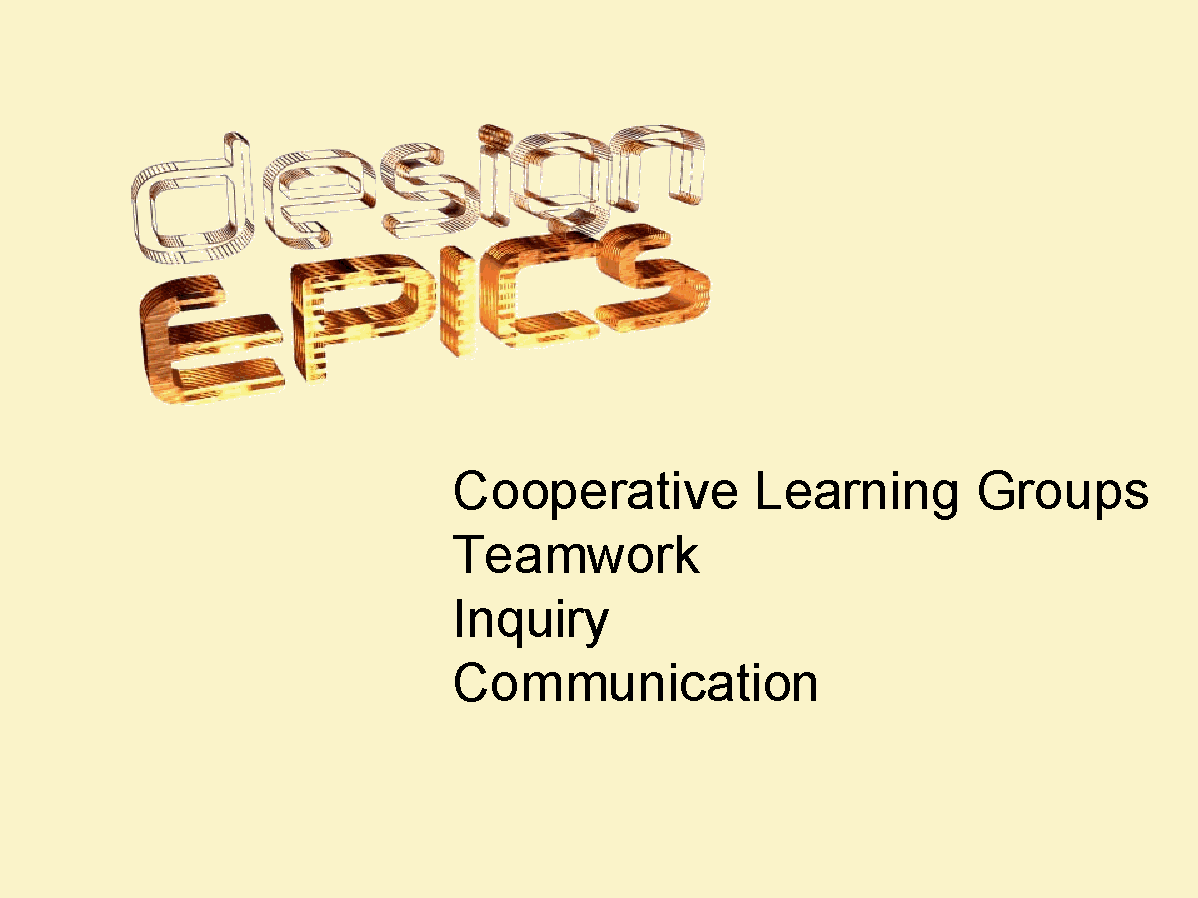 |
| We have, here
on the campus, the nucleus of a structure that is
designed to make us all better teachers., the Center
for Engineering Education (CEE).
Through this Center, as well as through the Office of
Teaching Effectiveness, many good things are already
happening. It’s clear that Mines has a well-founded
commitment to high quality education. The question is...how do we, as everyday teachers in the classroom, implement constructivism |
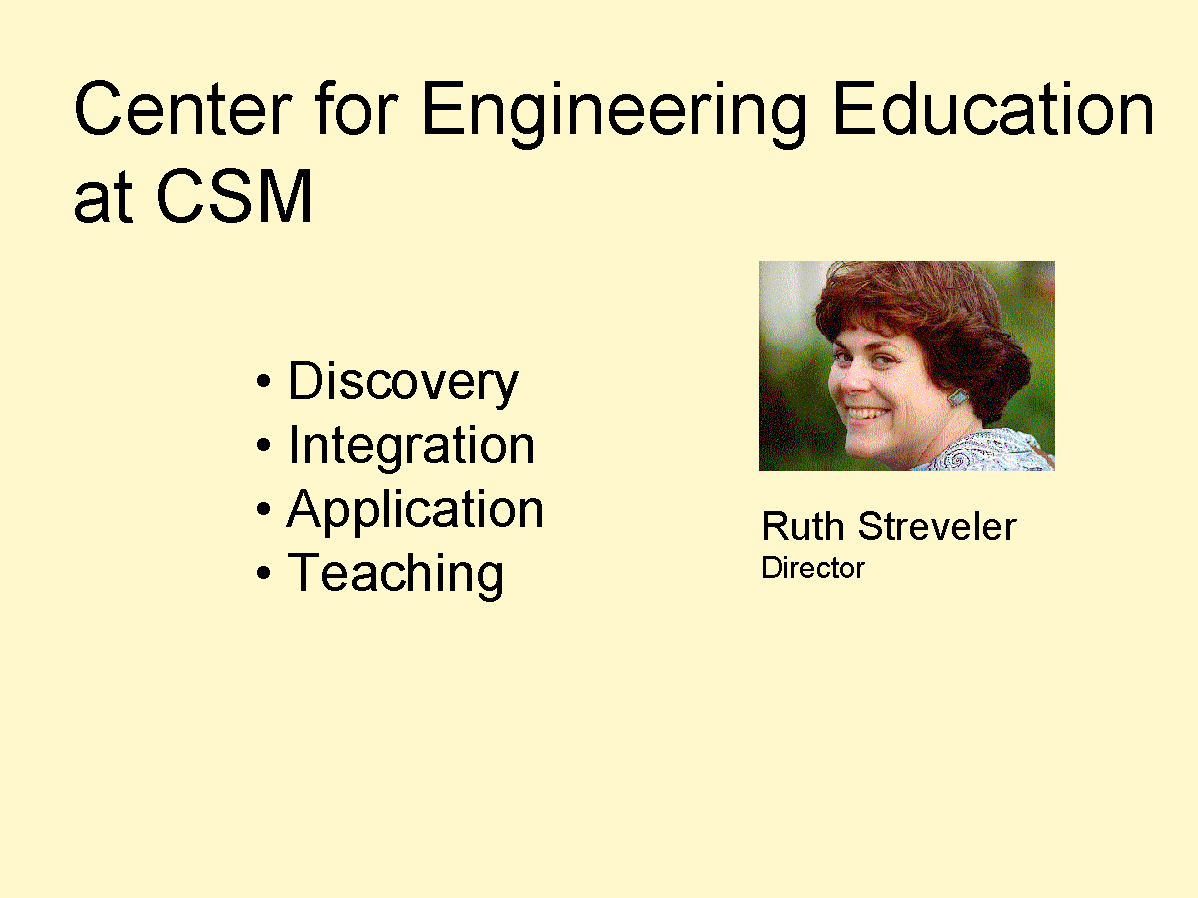 |
| Here are the
main points: The vertical arrow indicates how effectiveness increases as you go up in the hierarchy of the list. All educators, in any subject, at any level, can improve their teaching by installing these elements. The students must be actively engaged to learn. You must design the curriculum to encourage this. One of the most effective ways to get students involved is to use cooperative learning groups. I’ll spend most of the rest of the time telling you about this. It’s really the key idea, and one that we can all use. Beyond this, however, it is important to provide activities in which students design and answer questions about engaging situations, and that help them bridge the gap between their current perceptions and new knowledge. Finally, the assessment that goes along with this package needs to be very different from what we traditionally use. I’ll say a little bit about that at the end. |
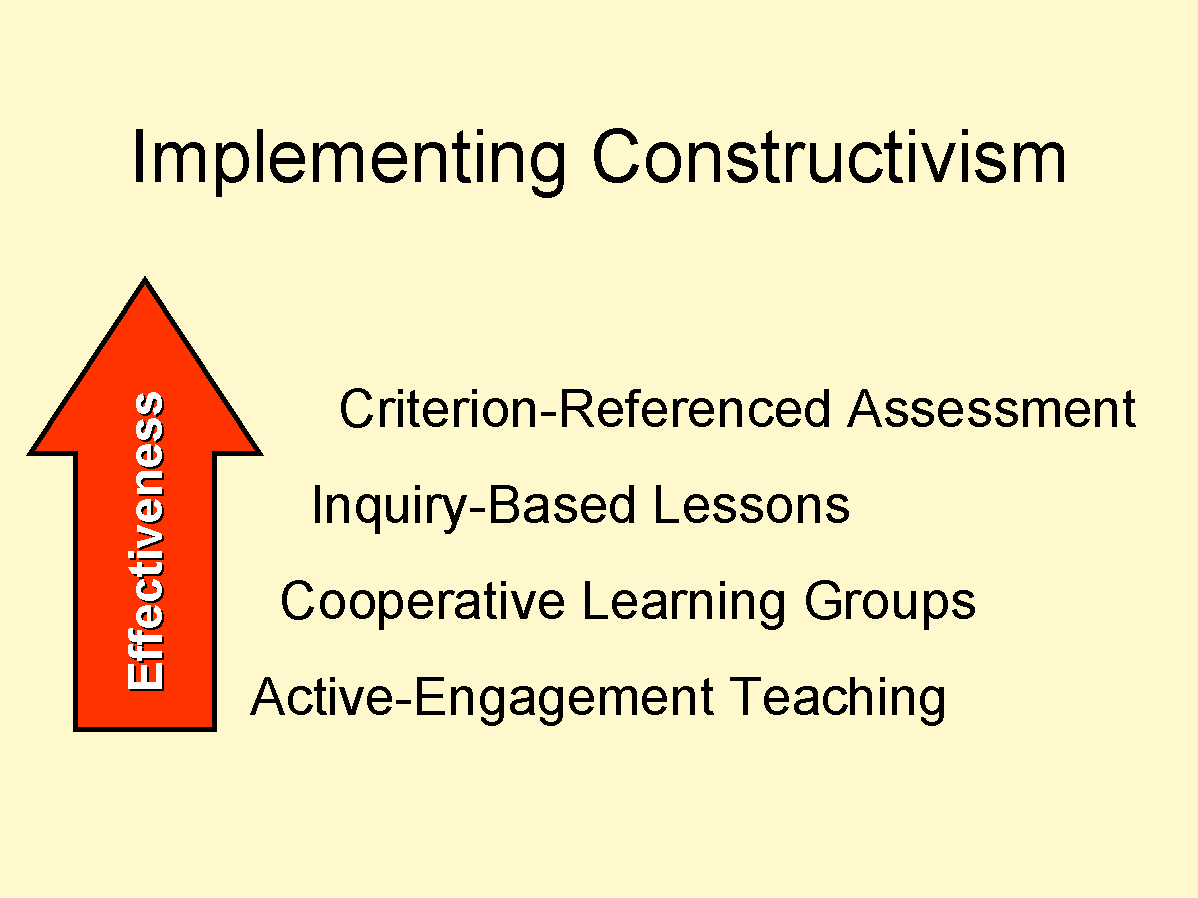 |
| These are the
basic elements of cooperative learning. The idea is to
get students interacting with each other in a productive
and supportive manner. But you can’t do it by just
turning them loose. That’s bound to fail. You have
to use carefully structured activities that pay attention
to these points: Talking to a receptive listener has been proven to be one of the most important ways to develop understanding. The classroom needs to be configured so that this knee-to-knee style of communication is natural. At some point, each student must be responsible for his or her own learning. They must assume this as a personal obligation that is part of the overall learning project. Accountability needs to be measured against absolute standards, however, not by comparisons among students in the class. Control of the action is in the hands of the students. The manner in which they interact needs to be managed. The instructions for the course must specify productive ways of interacting. The teacher must facilitate this while the groups are working. Finally, the groups need to spend some time assessing how the process is working. Cooperative learning groups can be as complex as the teams that are the essential part of EPICS. They are formalized for the entire semester. They can also be as simple as a pair of students discussing an idea in a large class. |
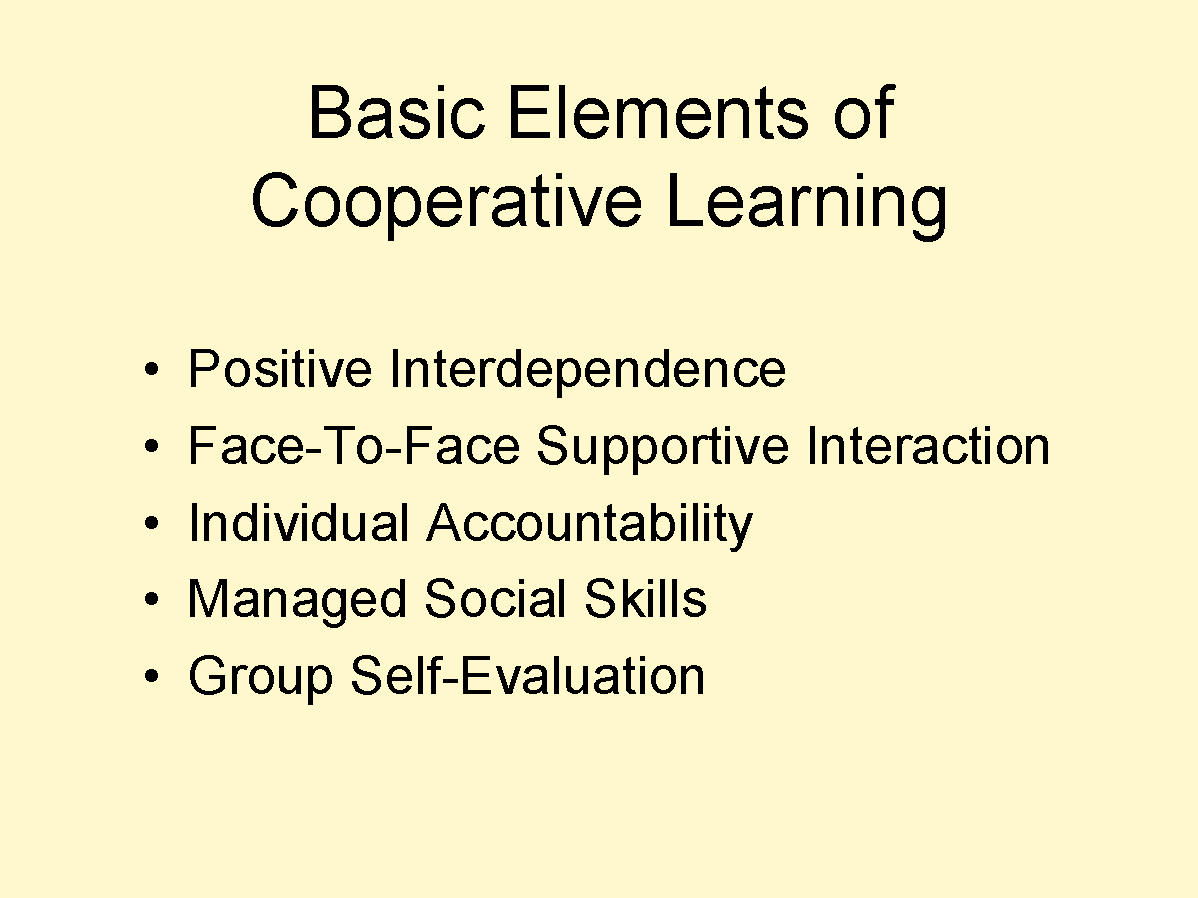 |
| This is the
most practical place to start. In your normal classroom,
under the traditional schedule, you can still use
cooperative learning groups with effectiveness. They
usually involve pairs of students talking to each other
in what would otherwise be a traditional lecture. Let me show you how informal groups can work in a physics class. |
 |
| The topic is
geometrical optics. The class period starts with a short
review of where we have been and where we are going. Then
the instructor would spend about five to ten minutes
introducing the concepts of reflection and refraction. A
few diagrams would be presented as part of this. A simple
qualitative demonstration using a laser pointer would
also be included. Then the flow of the class is stopped for a Concept-Test. A transparency with a thought-provoking question is displayed. Take a moment to read it. The rules are that students must think about this in silence for a couple of minutes, then commit themselves by writing down a letter on paper. After that, we vote. |
 |
| There are
different ways for a class to vote. Here we see
flashcards. Another way is by voice vote in "choir
style" with the instructor leading with a pointer.
The next part is the most important. The class is given a
short time during which the instructions are to
"convince your neighbor" that your answer is
correct. The room turns into a buzzing interaction center
while students explain their reasoning to each other.
They are then given a chance to change their mind, after
which a second vote is recorded. ******** photo credit:David Meltzer and Kandiah Manivannan, The Physics Teacher, 34, 72 (1996). |
 |
| There are
more sophisticated ways to vote. This is a hand-held
infrared transmitter. Students exchange their ID’s
at the door for one of these units. It comes equipped
with instructor software that enables real-time
histograms to be displayed. In most cases the second vote will reveal that the class collectively moves toward the correct answer. After this, the instructor reveals the correct answer and summarizes with a short explanation. (By the way, the correct answer is D, one-half your height. Did you get it right?) This method really works. Peers have legitimacy that superiors lack. Piaget pointed out that "social transmission" of knowledge is one of the most powerful forces in expanding students' thinking ability. Explaining things to a receptive listener is a very effective way to clarify ideas. Beyond these sound teaching principles, the simple "convince your neighbor" activity breaks down communication barriers, making it more possible to effectively use other types of cooperative grouping. Cooperative learning groups can be organized more formally, remaining fixed for one class period. Let’s see how to handle that. ******** credit: EduCue, 351 Alplaus Ave., Alplaus, New York 12008 |
 |
| In many of
our courses the objective is to help students learn how
to solve written problems. Here is one way to accommodate
this goal using learning groups. One of the rules is that all members of the group must agree on the strategy and answer to each problem. The group must make sure that all members understand. To install interdependence you can give a quiz at the end of the period. This quiz is taken individually. After the quiz is graded, you can randomly choose the score of one student in each group to be assigned to all members of the group. You need to allow time, perhaps on alternate days, for process evaluation. That means that the people in the group assess how the group functioned, and try to identify ways to improve everyone’s learning. |
 |
| One of the
things that you’ll notice with active-engagement
teaching is that there isn’t as much class time to
"cover material". You must rely more heavily on
reading assignments. Naturally, you need to install some
incentives. Few students will read an assignment just
because it’s listed in the syllabus. Here is a way
to use cooperative learning groups to handle outside
reading. It’s called the Jigsaw method. Different members of the group are given different parts of the assignment. On their own, each member reads their portion for understanding. But their understanding must be very good, because they are responsible for teaching that portion to the other members of the group. This takes place outside of class through a meeting that the students arrange. When the students come to class they are given a quiz on material in the entire reading assignment |
 |
| You can even use cooperative learning groups during a test. Here is one idea about how to do that. You administer the test under normal circumstances with one exception. There are two answer sheets. One of them is handed in for individual grading. The other is kept by the student for group processing. The groups meet during class time (while the instructor is present to facilitate and answer questions). They go over the test, making sure that all members of the group understand each question. The groups produce a collective answer sheet that is also graded. The students’ eventual grade on the test is some composite of the individual and the group scores. |  |
| The evidence is overwhelmingly in favor of constructivist teaching. Here again are results from the Force Concept Inventory. This time I’ve included assessments conducted in courses that use constructivist teaching principles. Remember that the horizontal axis is the fractional improvement, normalized to the maximum possible improvement. There is no question from this study that students learn better when they are actively involved, compared to the traditional approach (under which they passively sit and maybe take notes while the instructor does all the talking). |  |
| I’ve
used my own field as the primary example. However, the
conclusions about teaching methods are much more general
than that. Here is a summary of a recent survey that is
particularly comprehensive. Articles in educational journals are now beginning with the assumption that it is no longer necessary to justify that constructivist teaching is the most effective way to educate. There are other issues that come up. Among these is the question of computer technology and where it fits. In our disciplines of course, computers are an essential component of the curriculum. Beyond that, however, computers can be valuable in the process of teaching. As you may know, we have been working on a computer-assisted learning system in the Physics Department. |
 |
| Well...I
suppose this is one way to do it. But this isn’t our
procedure. What we have produced is called the Physics
Learning Studio. ******** cartoon credit: John McPherson, Close To Home 2000 |
 |
| The approach involves a specially equipped classroom and employs many of the methods that I have talked about here today. The system is managed by an extensive Web site that also serves to deliver content and to control a variety of learning software. |  |
| We use a
weekly learning cycle. Two of the class periods are held
under conventional conditions, in a large room. The other
two meetings are in the studio classroom. Students are
required to attend all four hours of the studio sessions
each week. That is when they engage in different
constructivist activities designed to get them talking to
each other and to develop complex thinking skills. The
computers play a secondary role. We use them for data
acquisition and analysis, simulations and tutorials. The
students are graded on a reading quiz at the beginning of
the cycle and computer-individualized homework at the end
of the cycle. The Web-based character of the course
facilitates extension of our learning community beyond
the classroom. We are pleased with the results, after three years of development. This is the system that will be installed into the Center for Technology and Learning Media (the CTLM) next fall |
 |
| I’ve
nearly finished with what I wanted to say. However,
before I close there are five recommendations that I
would like to suggest. It’s my firm belief that all
of us who teach can improve our effectiveness. Teaching
is like any challenging task. It requires constant
attention and correction. My first, and strongest, recommendation is for all of us who teach to start using constructivist strategies. Almost anything that you install, which gets the students actively involved during class, will help them learn better. However, start small. Don’t give up if it’s uncomfortable. This is really a new paradigm and it takes some adjustment. |
 |
| If you think about your own classrooms, or visit someone else’s, it’s easy to tell which mode is being used. In the constructivist mode control of the action, and of the learning, is in the hands of the students. It’s no wonder that some college faculty get tired of teaching by the old methods. Teaching under the new paradigm is different. It’s stimulating, and it’s fun. |  |
| My second recommendation goes along with the first. With more class time devoted to knowledge construction you will not be able to handle the same number of topics during that time. You need to make choices about the essential concepts and skills that you will treat in depth. |  |
| I’m sure that you have heard this claim before, "Less is more". This is really hard for us to accept. But we know that it is true. Robert Fuller, a nationally noted physics educator summed it up very well. He said, "Covering lots of content by lecturing...does not mean anything other than that your students have been exposed to many ideas. They could not necessarily use these ideas themselves." |  |
| My next recommendation is more demanding. Academic competition works against cooperative learning. It leads to an atmosphere of isolation and promotes a narrow mind set in the students. We need to stop using "norm-based" assessment. |  |
| Under
criterion-based assessment there are well-established
learning objectives that all students can reach. This
makes it possible for students to benefit from helping
each other. This doesn’t mean, of course, that we
abandon grades. What it suggests is that we, as
educators, understand what the students need to know and
how they need to grow. We award grades based upon their
progress toward those goals, not by how they compare to
their classmates. This gets us out of the "select and weed out" business and into the "nurture and improve" business. In the evaluation of our performance as an institution, wouldn’t it be great if we excelled at talent improvement. |
 |
| An individual faculty member can only do so much. The Colorado School of Mines has to make some changes also. It’s time to recognize that this is going to take some money and some program commitments. |  |
| Under the old
paradigm "lectures" are viewed as more valuable
than "labs", and academic credit is awarded
that way. A properly handled constructivist class is hard
work for the students. This needs to be recognized. Classrooms with chairs in rows are designed after the pattern of the lecture hall at the Royal Institution. If the students are interacting with each other in cooperative learning groups, the rooms themselves need to be re-designed. The teaching faculty needs to be expanded to include both professional support staff and permanent tenure-track slots for professionals dedicated to education scholarship. After all, is it not true that our primary mission is education? I’m only suggesting that we back that up with financial and human resources. |
 |
| Finally, we need to take teaching seriously and start giving it the respect that it deserves. As was noted by Jacques Barzun, historian and former Provost at Columbia University, "Teaching is not a lost art, but the regard for it is a lost tradition". |  |
| Here are a
few of the problems as I see them: We need to change the way we think about our jobs. We typically regard a new research project as an "opportunity", but the courses to which we are assigned are part of our teaching "load". The teaching part is an opportunity too, and one that we can’t afford to squander. It’s commonly assumed that anyone with a Ph.D. can teach, and that teaching is easy. That’s not true. Good teaching is hard work. Competence in a technical field does not guarantee competence as a teacher. We all must invest in learning how to teach. |
 |
| Why should
you pay any attention to what I’ve been saying? I
can hear some of you thinking that ‘a system which
isn’t broken doesn’t need fixing’. Well I
maintain that even a good system can and should be
improved. Here are just a few of the benefits that will
be realized if the Colorado School of Mines is able to
move toward a new paradigm in college teaching. I challenge you to do this! |
 |
| I’ve reached the end of my lecture. I’m sure that you haven’t missed the irony of this situation. I’ve been trying to convince you that communication by this method is not effective. So, if you happen to not remember much of what I’ve said, my point is, in fact...made. So, it seems appropriate to leave you with one last thought, which demonstrates that the ideas that I have been talking about are far from new. |  |
| Thank you for your attention. |  |